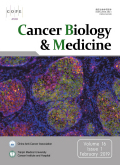- 钛学术文献服务平台 \
- 学术期刊 \
- 医药卫生期刊 \
- 肿瘤学期刊 \
- 癌症生物学与医学(英文版)期刊 \
VHH212 nanobody targeting the hypoxia-inducible factor 1α suppresses angiogenesis and potentiates gemcitabine therapy in pancreatic cancer in vivo
VHH212 nanobody targeting the hypoxia-inducible factor 1α suppresses angiogenesis and potentiates gemcitabine therapy in pancreatic cancer in vivo
基本信息来源于合作网站,原文需代理用户跳转至来源网站获取
摘要:
Objective: We aimed to develop a novel anti-HIF-1α intrabody to decrease gemcitabine resistance in pancreatic cancer patients. Methods: Surface plasmon resonance and glutathione S-transferase pull-down assays were conducted to identify the binding affinity and specificity of anti-HIF-1α VHH212 [a single-domain antibody (nanobody)]. Molecular dynamics simulation was used to determine the protein-protein interactions between hypoxia-inducible factor-1α (HIF-1α) and VHH212. The real-time polymerase chain reaction (PCR) and Western blot analyses were performed to identify the expressions of HIF-1α and VEGF-A in pancreatic ductal adenocarcinoma cell lines. The efficiency of the VHH212 nanobody in inhibiting the HIF-1 signaling pathway was measured using a dual-luciferase reporter assay. Finally, a PANC-1 xenograft model was developed to evaluate the anti-tumor efficiency of combined treatment. Immunohistochemistry analysis was conducted to detect the expressions of HIF-1α and VEGF-A in tumor tissues. Results: VHH212 was stably expressed in tumor cells with low cytotoxicity, high affinity, specific subcellular localization, and neutralization of HIF-1α in the cytoplasm or nucleus. The binding affinity between VHH212 and the HIF-1α PAS-B domain was 42.7 nM. Intrabody competitive inhibition of the HIF-1α heterodimer with an aryl hydrocarbon receptor nuclear translocator was used to inhibit the HIF-1/VEGF pathway in vitro. Compared with single agent gemcitabine, co-treatment with gemcitabine and a VHH212-encoding adenovirus significantly suppressed tumor growth in the xenograft model with 80.44% tumor inhibition. Conclusions: We developed an anti-HIF-1α nanobody and showed the function of VHH212 in a preclinical murine model of PANC-1 pancreatic cancer. The combination of VHH212 and gemcitabine significantly inhibited tumor development. These results suggested that combined use of anti-HIF-1α nanobodies with first-line treatment may in the future be an effective treatment for pancreatic cancer.

推荐文章
鲤科鱼类HIF-1的研究进展
HIF-1
鲤科鱼类
低氧应答
棉花ADP-ribosylation factor基因(GhARF1)的克隆与表达分析
ADP核糖基化因子
结构特征
G蛋白
棉花
HIF-1α/VEGF在肝细胞癌的表达及其与肿瘤血管生成的关系
肝细胞癌
缺氧诱导因子-1α
血管内皮生长因子
微血管密度
血管生成
密蒙花方对缺氧状态下脐静脉内皮细胞增殖及HIF-1а表达的影响
密蒙花方
脐静脉内皮细胞
增殖
缺氧诱导因子-1а
抑制
内容分析
关键词云
关键词热度
相关文献总数
(/次)
(/年)
文献信息
| 篇名 | VHH212 nanobody targeting the hypoxia-inducible factor 1α suppresses angiogenesis and potentiates gemcitabine therapy in pancreatic cancer in vivo | ||
| 来源期刊 | 癌症生物学与医学(英文版) | 学科 | |
| 关键词 | |||
| 年,卷(期) | 2021,(3) | 所属期刊栏目 | ORIGINAL ARTICLE |
| 研究方向 | 页码范围 | 772-787 | |
| 页数 | 16页 | 分类号 | |
| 字数 | 语种 | 英文 | |
| DOI | 10.20892/j.issn.2095-3941.2020.0568 | ||
五维指标
引文网络
引文网络
二级参考文献 (0)
共引文献 (0)
参考文献 (55)
节点文献
引证文献 (0)
同被引文献 (0)
二级引证文献 (0)
2001(1)
- 参考文献(1)
- 二级参考文献(0)
2002(1)
- 参考文献(1)
- 二级参考文献(0)
2004(1)
- 参考文献(1)
- 二级参考文献(0)
2005(1)
- 参考文献(1)
- 二级参考文献(0)
2006(3)
- 参考文献(3)
- 二级参考文献(0)
2008(6)
- 参考文献(6)
- 二级参考文献(0)
2010(2)
- 参考文献(2)
- 二级参考文献(0)
2011(2)
- 参考文献(2)
- 二级参考文献(0)
2012(5)
- 参考文献(5)
- 二级参考文献(0)
2013(6)
- 参考文献(6)
- 二级参考文献(0)
2014(4)
- 参考文献(4)
- 二级参考文献(0)
2015(4)
- 参考文献(4)
- 二级参考文献(0)
2016(2)
- 参考文献(2)
- 二级参考文献(0)
2017(3)
- 参考文献(3)
- 二级参考文献(0)
2018(4)
- 参考文献(4)
- 二级参考文献(0)
2019(7)
- 参考文献(7)
- 二级参考文献(0)
2020(2)
- 参考文献(2)
- 二级参考文献(0)
2021(1)
- 参考文献(1)
- 二级参考文献(0)
2021(1)
- 参考文献(1)
- 二级参考文献(0)
- 引证文献(0)
- 二级引证文献(0)
引文网络交叉学科
相关学者/机构
期刊影响力
癌症生物学与医学(英文版)
主办单位:
中国抗癌协会
出版周期:
季刊
ISSN:
2095-3941
CN:
12-1431/R
开本:
16开
出版地:
天津市河西区体院北环湖西路天津市肿瘤医院C座综合楼三楼
邮发代号:
6-173
创刊时间:
2004
语种:
eng
出版文献量(篇)
1054
总下载数(次)
0
总被引数(次)
2230
期刊文献
相关文献
推荐文献
- 期刊分类
- 期刊(年)
- 期刊(期)
- 期刊推荐
癌症生物学与医学(英文版)2022
癌症生物学与医学(英文版)2021
癌症生物学与医学(英文版)2020
癌症生物学与医学(英文版)2019
癌症生物学与医学(英文版)2018
癌症生物学与医学(英文版)2017
癌症生物学与医学(英文版)2016
癌症生物学与医学(英文版)2015
癌症生物学与医学(英文版)2014
癌症生物学与医学(英文版)2013
癌症生物学与医学(英文版)2012
癌症生物学与医学(英文版)2011
癌症生物学与医学(英文版)2010
癌症生物学与医学(英文版)2009
癌症生物学与医学(英文版)2008
癌症生物学与医学(英文版)2007
癌症生物学与医学(英文版)2006
癌症生物学与医学(英文版)2005

 免费查重
免费查重










